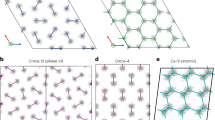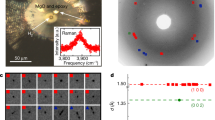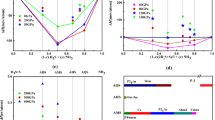Abstract
It is generally assumed1,2,3 that solid hydrogen will transform into a metallic alkali-like crystal at sufficiently high pressure. However, some theoretical models4,5 have also suggested that compressed hydrogen may form an unusual two-component (protons and electrons) metallic fluid at low temperature, or possibly even a zero-temperature liquid ground state. The existence of these new states of matter is conditional on the presence of a maximum in the melting temperature versus pressure curve (the ‘melt line’). Previous measurements6,7,8 of the hydrogen melt line up to pressures of 44 GPa have led to controversial conclusions regarding the existence of this maximum. Here we report ab initio calculations that establish the melt line up to 200 GPa. We predict that subtle changes in the intermolecular interactions lead to a decline of the melt line above 90 GPa. The implication is that as solid molecular hydrogen is compressed, it transforms into a low-temperature quantum fluid before becoming a monatomic crystal. The emerging low-temperature phase diagram of hydrogen and its isotopes bears analogies with the familiar phases of 3He and 4He (the only known zero-temperature liquids), but the long-range Coulomb interactions and the large component mass ratio present in hydrogen would result in dramatically different properties9.
This is a preview of subscription content, access via your institution
Access options
Subscribe to this journal
Receive 51 print issues and online access
$199.00 per year
only $3.90 per issue
Buy this article
- Purchase on Springer Link
- Instant access to full article PDF
Prices may be subject to local taxes which are calculated during checkout




Similar content being viewed by others
References
Wigner, E. & Huntington, H. B. On the possibility of metallic modifications of hydrogen. J. Chem. Phys. 3, 764–770 (1935)
Ashcroft, N. W. Metallic hydrogen: A high temperature superconductor? Phys. Rev. Lett. 21, 1748–1799 (1968)
Mao, H. K. & Hemley, R. J. Ultrahigh-pressure transitions in solid hydrogen. Rev. Mod. Phys. 66, 671–692 (1994)
Brovman, E. G., Kagan, Yu. & Kholas, A. Properties of metallic hydrogen under pressure. Sov. Phys. JETP 35, 783–792 (1972)
Ashcroft, N. W. The hydrogen liquids. J. Phys. Condens. Matter 12, A129–A137 (2000)
Diatschenko, V. et al. Melting curves of molecular hydrogen and molecular deuterium under high pressures between 20 and 373 K. Phys. Rev B 32, 381–389 (1985)
Datchi, F., Loubeyre, P. & LeToullec, R. Extended and accurate determination of the melting curves of argon, helium, ice (H2O) and hydrogen (H2). Phys. Rev. B 61, 6535–6546 (2000)
Gregoryanz, E., Goncharov, A. F., Matsuishi, K., Mao, H.-k. & Hemley, R. J. Raman spectroscopy of hot dense hydrogen. Phys. Rev. Lett. 90, 175701 (2003)
Ashcroft, N. W. Hydrogen at high density. J. Phys. A 36, 6137–6147 (2003)
Jayaraman, J., Newton, R. C. & McDonough, J. M. Phase relations, resistivity, and electronic structure of cesium at high pressure. Phys. Rev. 159, 527–533 (1967)
Scandolo, S. Liquid–liquid phase transition in compressed hydrogen from first-principles simulations. Proc. Natl Acad. Sci. USA 100, 3051–3053 (2003)
Kechin, V. V. Melting of metallic hydrogen at high pressure. JETP Lett. 79, 46–49 (2004)
Morris, J. R., Wang, C. Z., Ho, K. M. & Chan, C. T. Melting line of aluminum from simulations of coexisting phases. Phys. Rev. B 49, 3109–3115 (1994)
Ogitsu, T., Schwegler, E., Gygi, F. & Galli, G. Melting of lithium hydride under pressure. Phys. Rev. Lett. 91, 175502 (2003)
Alfe, D. First-principles simulations of direct coexistence of solid and liquid aluminum. Phys. Rev. B 68, 064423 (2003)
Bonev, S. A., Militzer, B. & Galli, G. Ab initio simulations of dense liquid deuterium: Comparison with gas-gun shock-wave experiments. Phys. Rev. B 69, 104101 (2004)
Chacham, H., Zhu, X. & Louie, S. G. Pressure-induced insulator-metal transitions in solid xenon and hydrogen: A first-principles quasiparticle study. Phys. Rev. B 46, 6688–6699 (1992)
Hemley, R. J. et al. Equation of state of solid hydrogen and deuterium from single-crystal x-ray diffraction to 26.5 GPa. Phys. Rev. B 42, 6458–6470 (1990)
Nagao, K., Bonev, S. A., Bergara, A. & Ashcroft, N. W. Enhanced Friedel structure and proton pairing in dense solid hydrogen. Phys. Rev. Lett. 90, 035501 (2003)
Yoshida, T. & Kamakura, S. Liquid-solid transitions in systems of soft repulsive forces. Prog. Theor. Phys. 52, 822–838 (1972)
Marzari, N. & Vanderbilt, D. Maximally localized generalized Wannier functions for composite energy bands. Phys. Rev. B 56, 12847–12856 (1997)
Souza, I., Martin, R. M., Marzari, N., Zhao, X. & Vanderbilt, D. Wannier-functional description of the electronic polarization and infrared absorption of high-pressure hydrogen. Phys. Rev. B 62, 15505–15519 (2000)
Izvekov, S., Parrinello, M., Burnham, C. J. & Voth, G. A. Effective force fields for condensed phase systems from ab initio molecular dynamics simulations: A new method for force-matching. J. Chem. Phys. 120, 10896–10913 (2004)
Hemley, R. J., Soos, Z. G., Hanfland, M. & Mao, H. K. Charge-transfer states in dense hydrogen. Nature 369, 384–387 (1994)
Moshary, F., Chen, N. H. & Silvera, I. F. Pressure dependence of the vibron in H2, HD, and D2: Implications for inter- and intramolecular forces. Phys. Rev. B 48, 12613–12619 (1993)
Loubeyre, P., Occelli, F. & LeToullec, R. Optical studies of solid hydrogen to 320 GPa and evidence for black hydrogen. Nature 416, 613–617 (2002)
Car, R. & Parrinello, M. Unified approach for molecular dynamics and density-functional theory. Phys. Rev. Lett. 55, 2471–2474 (1985)
Perdew, J. P., Burke, K. & Ernzerhof, M. Generalized gradient approximation made simple. Phys. Rev. Lett. 77, 3865–3868 (1996)
Steinhardt, P. J., Nelson, D. R. & Ronchetti, M. Bond-orientational order in liquids and glasses. Phys. Rev. B 28, 784–805 (1983)
Kechin, V. V. Melting curve equations at high temperature. Phys. Rev. B 65, 052102 (2001)
Acknowledgements
We thank S. Izvekov for providing the force-matching routines that were used in the analysis shown in the inset of Fig. 4, and F. Gygi for many discussions. This work was performed under the auspices of the US Department of Energy at the University of California/Lawrence Livermore National Laboratory.
Author information
Authors and Affiliations
Corresponding author
Ethics declarations
Competing interests
The authors declare that they have no competing financial interests.
Rights and permissions
About this article
Cite this article
Bonev, S., Schwegler, E., Ogitsu, T. et al. A quantum fluid of metallic hydrogen suggested by first-principles calculations. Nature 431, 669–672 (2004). https://doi.org/10.1038/nature02968
Received:
Accepted:
Issue Date:
DOI: https://doi.org/10.1038/nature02968
This article is cited by
-
Superionic iron alloys and their seismic velocities in Earth’s inner core
Nature (2022)
-
The high-pressure lithium–palladium and lithium–palladium–hydrogen systems
Scientific Reports (2022)
-
High pressure synthesis of phosphine from the elements and the discovery of the missing (PH3)2H2 tile
Nature Communications (2020)
-
Understanding dense hydrogen at planetary conditions
Nature Reviews Physics (2020)
-
Understanding high pressure molecular hydrogen with a hierarchical machine-learned potential
Nature Communications (2020)
Comments
By submitting a comment you agree to abide by our Terms and Community Guidelines. If you find something abusive or that does not comply with our terms or guidelines please flag it as inappropriate.



